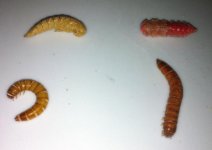cheddarness8
New member
I've cultured feeder arthropods in the past (mostly aquatic), and had decent success. I've only housed crickets and mealworms in the past, however, and never bred them. Recently I've started a mealworm farm , and I have had a funny surprise.
I happened across some "red mealworms" at a local gas station, and I couldn't resist picking up two dozen of them just for fun. I haven't used them to feed, just popped them in with the rest and allowed them to pupate. The more beetles, the merrier! They are T. motilor, from what I can tell, and not a misidentified larva of another beetle. Apparently used for fishing, they're dark red on the outside. I thought maybe they'd been dipped in some dye, and it would wear off. Instead, one pupated, and surprise- their flesh is hot pink inside. From what I can tell, they must be fed a dye which isn't broken down during digestion, just stored in body fat.
This is just something odd that I thought would be fun to share. Does anyone know what they're fed? I wonder if the dye is metabolized in herps or if it's toxic.
Enjoy the photo!
The normal pupa and larva are on the left. The artificially dyed larva and pupa are on the right.
I happened across some "red mealworms" at a local gas station, and I couldn't resist picking up two dozen of them just for fun. I haven't used them to feed, just popped them in with the rest and allowed them to pupate. The more beetles, the merrier! They are T. motilor, from what I can tell, and not a misidentified larva of another beetle. Apparently used for fishing, they're dark red on the outside. I thought maybe they'd been dipped in some dye, and it would wear off. Instead, one pupated, and surprise- their flesh is hot pink inside. From what I can tell, they must be fed a dye which isn't broken down during digestion, just stored in body fat.
This is just something odd that I thought would be fun to share. Does anyone know what they're fed? I wonder if the dye is metabolized in herps or if it's toxic.
Enjoy the photo!
The normal pupa and larva are on the left. The artificially dyed larva and pupa are on the right.


